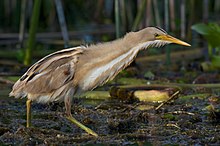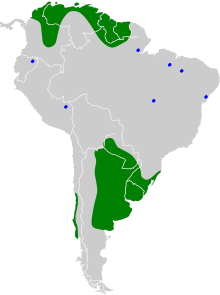Stripe-backed bittern
| Stripe-backed bittern | |
|---|---|

| |
| Scientific classification | |
| Domain: | Eukaryota |
| Kingdom: | Animalia |
| Phylum: | Chordata |
| Class: | Aves |
| Order: | Pelecaniformes |
| Family: | Ardeidae |
| Genus: | Botaurus |
| Species: | B. involucris
|
| Binomial name | |
| Botaurus involucris (Vieillot, 1823)
| |

| |
The stripe-backed bittern (Botaurus involucris) is a South American bird species belonging to the family Ardeidae, which includes Herons, Egrets and Bitterns. It was formerly placed in the genus Ixobrychus. Commonly found near freshwater swamps, marshes, lake shores and streams, stripe-backed bitterns span over a wide distribution that divides into the northern and southern populations, spanning on both sides of the Andes.[2] Although increasingly recognized and researched worldwide, much life history details are lacking concerning this species, which remains understudied compared to its similar looking sister clade, including the least bittern (Botaurus exilis).
Taxonomy
[edit]The stripe-backed bittern was formally described in 1823 by the French ornithologist Louis Vieillot under the binomial name Ardea involucris.[3][4] Vieillot based his account on the "Garza varia" that had been described in 1805 by Spanish naturalist Félix de Azara in his Apuntamientos para la historia natural de los páxaros del Paragüay y Rio de la Plata.[5] The stripe-backed bittern was formerly placed in the genus Ixobrychus but when a molecular phylogenetic study of the heron family Ardeidae published in 2023 found that Ixobrychus was paraphyletic, Ixobrychus was merged into Botaurus.[6][7][8] The species is treated as monotypic: no subspecies are recognised.[7]
Description
[edit]
Stripe-backed bitterns are very small, averaging from 28 to 35 cm in length.[9] Their pale brown back is ornamented with both black and yellowish-beige streaks, the latter also running along their broad wings.[10] The colour patterns on their back complements the ones on their wings as to suppress obvious contrast between the two. Black stripes continue their way on the darker brown crown, while the underbelly is lighter brown and striped with white.[9] As for the beak, the colour can differ from pale green to orange.[10] This bittern species exhibits no sexual dimorphism, making it difficult to distinguish males from females.[10] Furthermore, juveniles are not phenotypically described in the literature. Discriminating gender and age for this species has proved to be a challenge, so has the simple quest to even observe them in the wild. Stripe-backed bitterns tend to adopt an upright stance in which they “freeze” in place to observe their surroundings, making it more efficient to hunt their preys.[2] When threatened, they respond by pointing their neck and bill skyward. This augments the difficulty to spot them easily. Following a solitary lifestyle, chances of finding them in groups are scarce but sights in pairs have been reported in the past.[10]
Similar species
[edit]The stripe-backed bittern is easily confused with the least bittern. The most striking difference consist of the contrast between the dark coloured, completely streak less back of the least bittern, compared to its patterned wings.[11] Least bitterns also differ by the rufous coloration on the sides of their head, also present on the neck of females.[9]
Distribution and habitat
[edit]Distribution
[edit]Displaying a disjunct, yet wide distribution, stripe-backed bitterns are found on each side of the Andes. A northern population is distributed in large patches across South America, located in Colombia, Venezuela, Guyana, Suriname, French Guiana and the island of Trinidad, while a southern population is found in central and southern South America; in Paraguay, Uruguay, Argentina, Chile, southern Brazil and Bolivia.[9] In 2018, the presence of stripe-backed bitterns have also been confirmed in northeastern Ecuador, as well as in southeastern Peru.[9]
Habitat
[edit]Freshwater sources are favoured as habitats for stripe-backed bitterns. Ideal ecological niches consist of highly vegetated reed beds, swamps, rushes, lakes and mountain streams, marshes, and rice fields.[9][10] Such aquatic environments are essential in food acquisition, and in requirements for nest building.
Behaviour
[edit]Diet
[edit]The most prominent food source for stripe-backed bitterns, comprising half of their overall diet, are insects. More specifically, they preferably consume insects from the orders Odonata, Coleoptera, Hemiptera and Orthoptera.[12] The remaining half of their food intake is sourced from small fishes, crustaceans, and arachnids.[12][13] Stripe-backed bitterns are diurnal birds. They tend to intensify their activities such as active hunting either early in the morning or in the afternoon, prioritizing rest at noon and at sunset.[12] They have been recorded to feed either alone, or in pairs.[13] Night feeding has also been reported, but only scarcely.
Reproduction
[edit]The reproduction cycle and breeding details of stripe-backed bitterns have not been extensively studied, and much of it is still unknown. What we do know is that this species is not a strong flier, and only does fly across short distances. Their nests are consequently not found high up in trees. Stripe-backed bitterns makes small nests of tightly bound reeds and stems, which are found above water level, among reeds.[10] Incubation period for eggs is unknown, and breeding seasons appear to vary widely based on location.
Eggs
[edit]Stripe-backed bitterns have not been represented widely in the literature, especially due to the rarity of sight, as well as the scarcity of information concerning many of their life history traits. However, one topic has often resurged throughout history; the evolutionary explanation for stripe-backed bitterns’ distinct egg colour.
Ardeidae is a family of birds known to yield eggs of either elliptical or spherical shape, which are often pale blue in colour.[14] The translucent layer of their eggs, combining the commonly called cone and palisade layers, allows a glimpse into the blue or white inner shell.[14] The eggs of stripe-backed bitterns, uniquely, exhibit pale blue cone and palisade layers, covered by an outer translucent green layer.[14] Although recurrent observations/descriptions have been published, the evolutionary explanation for such a unique egg coloration within the Ardeidae bird family, remains unsolved to this day.
Vocalization
[edit]Sounds have been elaborately described and are sometimes the best way to determine the presence of stripe-backed bitterns, emitting calls through distinct, low-pitched ooks, or through gargling.[10] Territorial or warning vocalizations consist of four low-pitched short “huu” or “ook” notes, followed by a second type of vocalization; a faster and higher-pitched “g’u’u’u’a’a” gargle.[10]
Status
[edit]This bittern is considered to be of least concern, due to its wide range, and its large, stable population.[15] As per information gathered by the IUCN Red List of threatened species, stripe-backed bitterns do not receive much conservation efforts, nor do they constitute a priority for outreach education programs, as their status is well anchored in the Least concerned section and is not foreseen to switch to a Vulnerable status anytime soon.
External links
[edit]- Photos and sounds of stripe-backed bitterns Ixobrychus involucris - eBird
- Photos of stripe-backed bitterns, Birds of the World - The Cornell Lab of Ornithology
- Photos of stripe-backed bitterns - iNaturalist
- Conservation status of stripe-backed bitterns - IUCN Red List of Birds
References
[edit]- ^ BirdLife International (2016). "Ixobrychus involucris". IUCN Red List of Threatened Species. 2016: e.T22697294A93606613. doi:10.2305/IUCN.UK.2016-3.RLTS.T22697294A93606613.en. Retrieved 12 November 2021.
- ^ a b Behrstock, Robert A. (1996). "Voices of Stripe-backed Bittern Ixobrychus involucris, Least Bittern I. exilis, and Zigzag Heron Zebrilus undulatus, with notes on distribution" (PDF). Cotinga 5 (5): 56 – via Neotropical Birding and Conservation.
- ^ Vieillot, Louis Pierre (1823). Tableau encyclopédique et méthodique des trois règnes de la nature. Ornithologie (in French). Vol. 3. Paris: Mme veuve Agasse. p. 1127 livrason 93.
- ^ Mayr, Ernst; Cottrell, G. William, eds. (1979). Check-List of Birds of the World. Vol. 1 (2nd ed.). Cambridge, Massachusetts: Museum of Comparative Zoology. p. 238.
- ^ Azara, Félix de (1805). Apuntamientos para la historia natural de los páxaros del Paragüay y Rio de la Plata (in Spanish). Vol. 3. Madrid: Imprenta de la Hija de Ibarra. p. 185, No. 361.
- ^ Hruska, J.P.; Holmes, J.; Oliveros, C.; Shakya, S.; Lavretsky, P.; McCracken, K.G.; Sheldon, F.H.; Moyle, R.G. (2023). "Ultraconserved elements resolve the phylogeny and corroborate patterns of molecular rate variation in herons (Aves: Ardeidae)". Ornithology: ukad005. doi:10.1093/ornithology/ukad005.
- ^ a b Gill, Frank; Donsker, David; Rasmussen, Pamela, eds. (August 2024). "Ibis, spoonbills, herons, Hamerkop, Shoebill, pelicans". IOC World Bird List Version 14.2. International Ornithologists' Union. Retrieved 20 August 2024.
- ^ Chesser, R.T.; Billerman, S.M.; Burns, K.J.; Cicero, C.; Dunn, J.L.; Hernández-Baños, B.E.; Jiménez, R.A.; Johnson, O.; Kratter, A.W.; Mason, N.A.; Rasmussen, P.C.; Remsen, J.V.J. (2024). "Sixty-fifth Supplement to the American Ornithological Society's Check-list of North American Birds". Ornithology. 141 (3): ukae019. doi:10.1093/ornithology/ukae019.
- ^ a b c d e f Kilby, Rachel; Ugarte, Mauricio; Timson, Stuart; Góngora Romero, Dennys (2018-05-18). "First documented record of the Stripe-backed Bittern, Ixobrychus involucris (Vieillot, 1823) (Aves, Ardeidae) in Peru". Check List. 14 (3): 519–522. doi:10.15560/14.3.519. ISSN 1809-127X.
- ^ a b c d e f g h Martínez-Vilalta, A.; Motis, A.; Kirwan, G.M. (2020). del Hoyo, J.; Elliott, A.; Sargatal, J.; Christie, D.A.; de Juana, E. (eds.). "Stripe-backed Bittern (Ixobrychus involucris), version 1.0". Birds of the World. Ithaca, NY, USA: Cornell Lab of Ornithology. Retrieved 20 August 2024.
- ^ Gochfeld, Michael (1973). "Observations on New or Unusual Birds from Trinidad, West Indies, and Comments on the Genus Plegadis in Venezuela". The Condor. 75 (4): 474–478. doi:10.2307/1366575. ISSN 0010-5422. JSTOR 1366575.
- ^ a b c Leon, Evelina J; Olguin, Pamela F; Beltzer, Adolfo H (2016-04-18). "Aportes al conocimiento de la dieta del mirasol chico (Ixobrychus involucris) (Aves: Ardeidae) en el valle de inundación del río Paraná Medio, Argentina". Fabicib. 19: 65–71. doi:10.14409/fabicib.v19i0.5416. hdl:11336/59958. ISSN 2362-5546.
- ^ a b Ulrich; Willett, Pedro K.; Julien H. (2010). Trends in ornithology research. New York: Nova Science. pp. 49–85. ISBN 9781619423268.
{{cite book}}: CS1 maint: multiple names: authors list (link) - ^ a b c Walters, Michael (2006). "Colour in birds' eggs: the collections of the Natural History Museum, Tring". Historical Biology. 18 (2): 148. Bibcode:2006HBio...18..145W. doi:10.1080/08912960600640887. S2CID 84171126 – via Taylor & Francis online.
- ^ "Stripe-backed bittern". IUCN Red List. 2016.
- ffrench, Richard (1991). A Guide to the Birds of Trinidad and Tobago (2nd ed.). Comstock Publishing. ISBN 0-8014-9792-2.
- Junge, G.C.A.; Mees, G.F. (1961). Avifauna of Trinidad and Tobago. E.J. Brill.
- Kushlan, James A.; Hancock, James A. (2005). Herons. Oxford University Press. ISBN 0-19-854981-4.
- "Ixobrychus involucris". Cornell Lab of Ornithology. Retrieved 24 February 2015.

